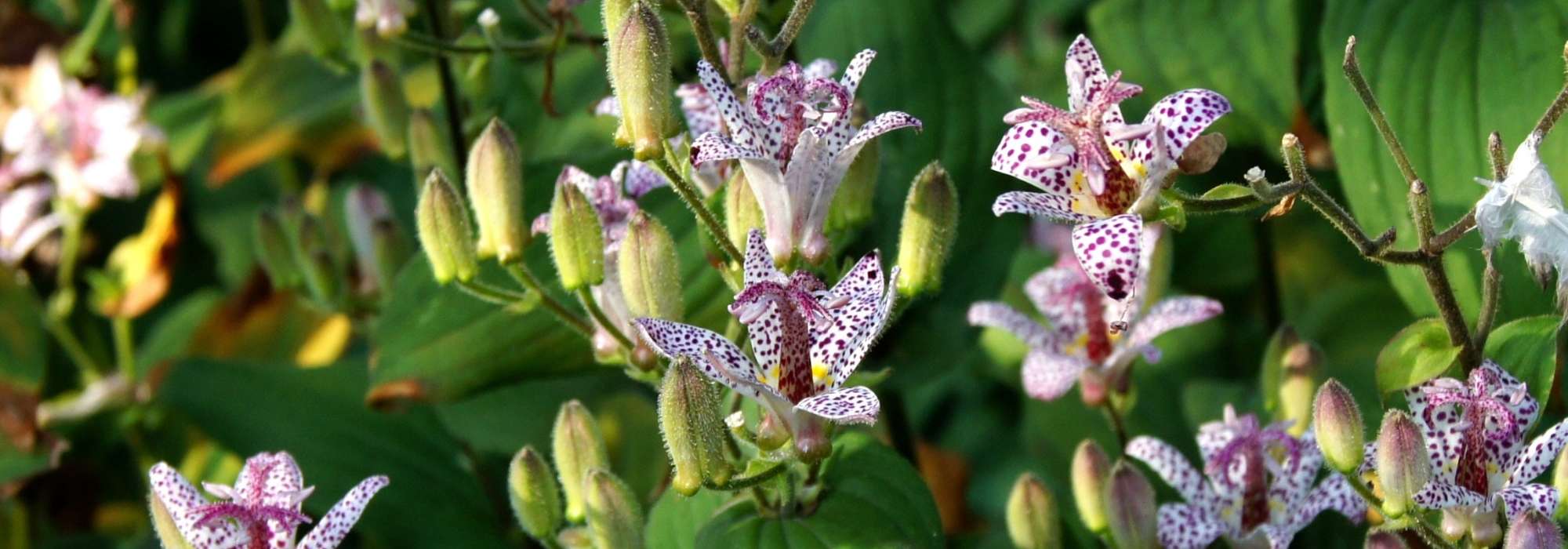
Tricyrtis, toad lily: planting, growing, care
Contents
Tricyrtis in a nutshell
- tricyrtis, or ‘toad lily’, is a small perennial ideal for cool, partly shaded corners of the garden.
- Its star-shaped flowers, freckled with small coloured spots, have the charm of orchids and add an exotic touch to the garden.
- This deciduous, easy-to-grow perennial, preferring partial shade and humus-bearing, fresh soils, comes into its own in autumn with unusual, distinctively coloured flowers that open at the stem tips.
- Very hardy, tricyrtis can be multiplied by propagation by cuttings in summer or, more easily, by dividing clumps in spring.
A word from the expert
Rhizomatous perennial growing wild in East Asia, Tricyrtis brings an exotic note to the garden, both through its oriental origins and its delicate flowering reminiscent of orchids.
From a compact clump, which produces suckers steadily but surely to reach about sixty centimetres wide, emerge stems 60 to 90 cm, with an upright habit and bearing flowers similar to small orchids.
In summer and autumn, the flowers of tricyrtis, commonly known as ‘toad lily’ or ‘orchid-lily’, are small, star-shaped graphic jewels 3 to 4 cm across.
Some display white to pinkish tones punctate with small touches of purple, as in Tricyrtis hirta ‘Miyazaki’. Sometimes ground colour is darker and spotting lighter, as with Tricyrtis hirta ‘Raspberry Mousse’.
Foliage is no exception. Shiny, generous, it can be true green or show unusual colours such as that of Tricyrtis hirta ‘Albomarginata’ with elegant variegation.
All prefer humus-bearing soils that remain cool, and semi-shaded positions. Hardy and easy to grow, it has only slugs and snails as potential enemies.
Description and botany
Botanical data
- Latin name Tricyrtis
- Family Liliaceae
- Common name Toad lily, toad lilies, orchid lily
- Flowering summer/autumn
- Height 30 cm to 1 m with 60 cm spread
- Sun exposure partial shade, light shade, non-scorching sun
- Soil type humus-bearing, remaining fresh but well-drained, neutral to acid
- Hardiness very good (-15°C)
Tricyrtis is a perennial plant native to East Asia, from China, Korea and Japan in north to Nepal, Taiwan and the Philippines in south. In native habitat it is found at forest edges and along watercourses. This perennial grows both in Himalayan mountain regions and in subtropical forests. In all cases, it favour soils that do not dry out in summer.
Although growing from rootstocks rather than bulbs, toad lily belongs to family Liliaceae, like fritillaries or tulips, and about twenty species exist including Tricyrtis latifolia (earlier flowering), Tricyrtis affinis or Tricyrtis ohsumiensis but most commonly used in gardens are Tricyrtis formosana and Tricyrtis hirta.
Deciduous leaves, glossy green and crossed by prominent veins, measure around 10 cm long and are lanceolate or ovate. Alternate, they are inserted singly on either side of stem and resemble those of Solomon’s seal. Their petioles are often sheathing. Certain varieties, such as Tricyrtis hirta ‘Albomarginata’, even display bright, cream-margined foliage.
Thanks to slightly running rootstocks, these perennials quickly form handsome clumps about 60 cm wide and as high. Some varieties reach 90 cm, such as Tricyrtis formosana. All parts of plant are pubescent, covered with a fine down.
Despite unflattering common name, toad lily offers a most delicate flowering with habit more or less erect according to variety. Depending on species, flowering occurs in summer or autumn. Flowers about 3 cm open in terminal cymes. They consist of three sepals and three petals that open star-shaped. At their base sit three small nectar sacs that gave this lily its Latin name. Tricyrtis comes from Greek ‘tri’ (three) and ‘kyrtos’ (bulge) and refers to these sacs. A central column, called spur, bears stigmas that echo same hues and patterns as tepals.

Some toad lily flowers: Tricyrtis ‘Trojen’, Tricyrtis hirta ‘Miyazaki’, Tricyrtis hirta ‘Taiwan Abdane’ and Tricyrtis hirta ‘Raspberry Mousse’ (photo henryr10)
Some species, such as Tricyrtis macrantha, have fused tepals giving flower a bell-like, campanulate aspect similar to campanulas.
Flowers of this ‘poor man’s orchid’, as English speakers sometimes call it, mostly show white or pale yellow shades freckled with hundreds of purple dots. Some also display more intensely coloured areas from blue to mauve to pink. Delicacy of flower deserves close inspection to appreciate fully its beauty, graphic patterning and complexity.
Flowers then produce small cylindrical pods that open to release tiny, flattened round seeds. Under good cultivation conditions, sowing will naturally give rise to new plants whose colours will vary according to natural hybridization.
Different varieties of Tricyrtis

Tricyrtis hirta - Toad Lily
- Flowering time September to November
- Height at maturity 60 cm
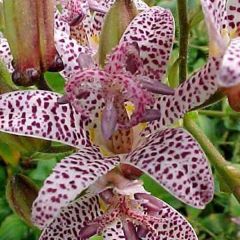
Tricyrtis hirta Miyazaki - Toad Lily
- Flowering time September, October
- Height at maturity 60 cm
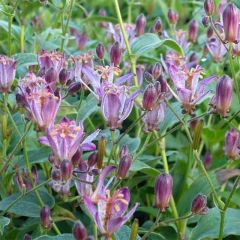
Tricyrtis hirta Taiwan Abdane - Toad Lily
- Flowering time September to November
- Height at maturity 70 cm
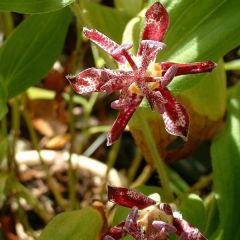
Tricyrtis hirta Raspberry Mousse - Toad Lily
- Flowering time September, October
- Height at maturity 60 cm
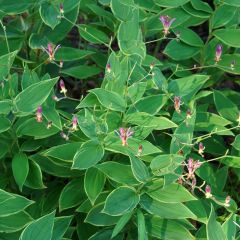
Tricyrtis hirta Albomarginata - Toad Lily
- Flowering time October, November
- Height at maturity 60 cm
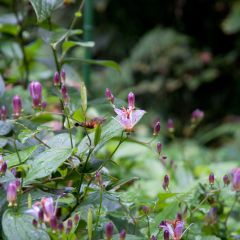
Tricyrtis formosana - Toad Lily
- Flowering time September to November
- Height at maturity 90 cm
Discover other Tricyrtis - Japanese Toad Lily
View all →Available in 1 sizes
Available in 1 sizes
Available in 1 sizes
Available in 3 sizes
Available in 2 sizes
Available in 1 sizes
Available in 1 sizes
Available in 1 sizes
Available in 1 sizes
Available in 1 sizes
Planting Tricyrtis
Where to plant tricyrtis?
Plant your toad lilies in shaded or semi-shaded positions under cover of trees or bushes that will protect them from heat. They can tolerate a sunnier position provided soil does not dry out in summer. Position them in front of borders, shaded rockeries, or at edge of a pond or a stream.
If your soil is too dry or too calcareous, try them in pots as well — they adapt very well. Close to the house you can easily admire all their refinement. They are also perfect to brighten up a difficult corner of the garden. Their beautiful late-season starry flowering of delicate stars can also decorate a shaded balcony or terrace.
They prefer above all deep, light soils, rich in organic matter and fresh, but will suffer in heavy, clay soils waterlogged in winter. Avoid soils that are too calcareous and prefer those slightly acidic to neutral.
When to plant?
Plant tricyrtis ideally in autumn if climate is mild and not too wet. Otherwise, choose spring. In all cases, always plant outside frost periods.
How to plant?
Planting in open ground :
- Soak the bucket in a pail or basin of water for 5 to 10 minutes. Rootball must be evenly moistened before planting.
- Loosen soil deeply with a digging fork, breaking up any clods. Remove roots of unwanted weeds.
- Add well‑rotted compost or well‑decomposed manure. In heavy soil add river sand. Mix with original soil.
- Dig a hole three times size of the bucket (about 30 centimetres in all directions for a 9 cm bucket)
- Remove from bucket and place your tricyrtis so that the collar of the plant (the part separating foliage from roots) is level with the soil. If rootball has no foliage yet, simply ensure its top is at same level as soil.
- Firm slightly with the fist and form a small basin by hand around the plant so it benefits fully from watering.
- Mulch to about 5 to 10 centimetres thick and approximately 30 cm diameter (dead leaves, pales of flax or hemp, ramial chipped wood…) taking care to leave the collar exposed. This will conserve freshness and limit watering and weed growth, while providing humus.
- Water, even in case of rain, to ensure soil adheres well to roots.
Toad lily appreciating soils that are always fresh, ensure regular watering if rainfall is too low. For a massed effect, allow 5 plants per m².
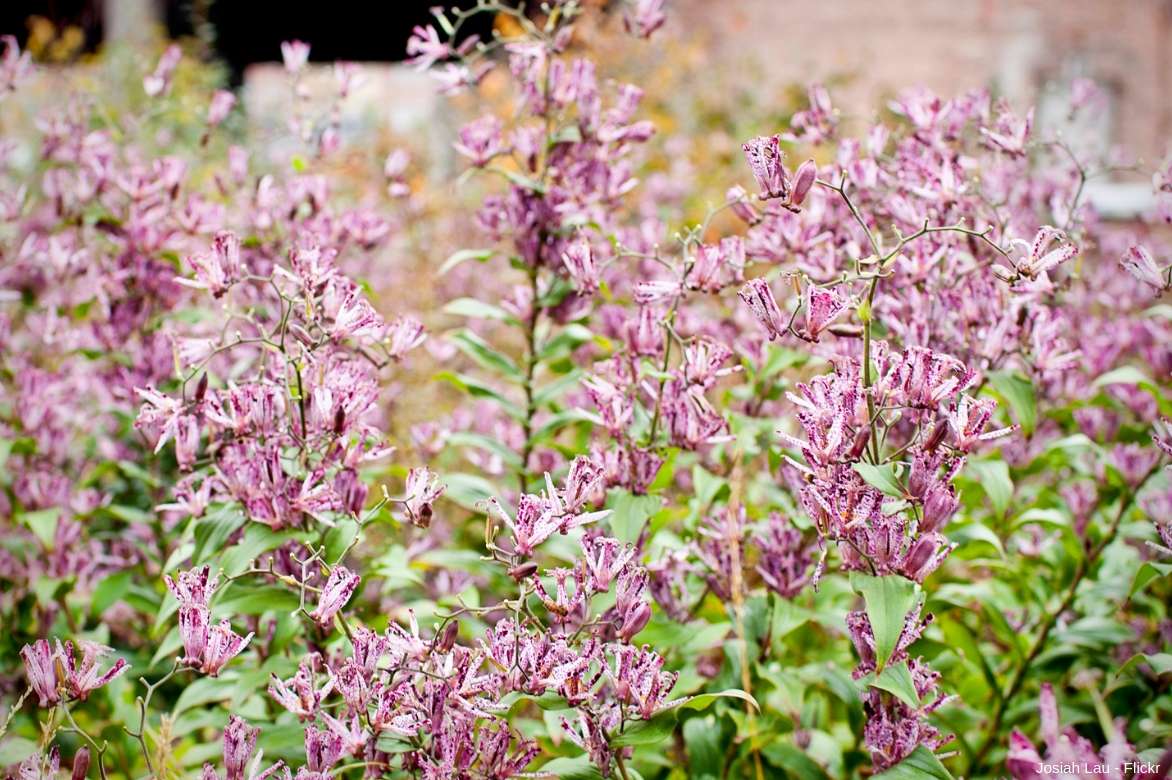
Caring for Tricyrtis
Tricyrtis have few pests. Slugs and snails can sometimes attack young foliage in early spring. Natural, effective methods exist, for example using iron oxide pellets.
If leaves turn brown it is very likely the soil is too dry. Remember to water, especially during growth and flowering (spring to autumn). This is all the more important if grown in a pot.
Tricyrtis appreciate a mulch at their base. Choose flax or hemp chips, buckwheat hulls, BRF (ramial chipped wood) or dead leaves. This will help retain good moisture and limit growth of unwanted weeds. Mulch should be 5 to 10 cm thick over about 30 cm diameter and should not touch the base of the plant to avoid risk of rot.
They are deciduous perennials: they die back completely in winter. In open ground, mark their position (for example with a wooden stake) so you do not risk damaging them during early-season tidy-ups.
Around March, add compost and top up mulch if necessary.
The toad lily requires no pruning. You can cut off spent flower stems but you will then have no seeds. If any remain into early spring, cut them back to their base.
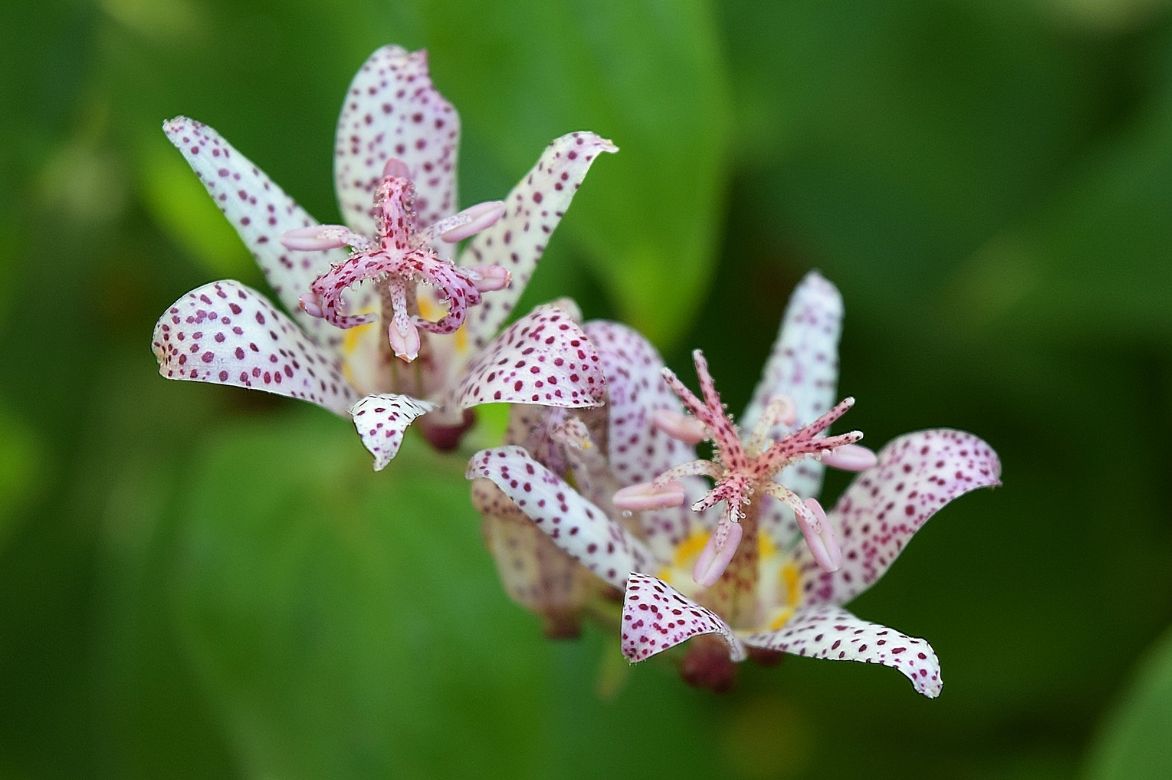
Propagate Tricyrtis
tricyrtis are propagated by stem cuttings in autumn but clump division in spring remains simplest and most effective solution.
Propagation by cuttings
Propagation by cuttings should be carried out between late spring and summer, when stems have not yet developed their buds.
- Take stem cuttings about ten centimetres long. Cut top of cutting just above a leaf and leave lower part bare.
- Insert cuttings into light potting compost (mix with sand if needed) until leaf is level with substrate.
- Keep in a cool, bright place, out of direct sunlight. Keep potting compost moist
- Plant in permanent position next autumn.
Clump division
Unlike some perennials, division of tricyrtis is not obligatory. It does, however, produce several plants to enjoy siting elsewhere in garden. Carry out in spring, when plant resumes growth.
- Choose a well-established, well-developed young plant.
- With a spade, cut around plant (about 30 cm from centre) then lift it.
- Still with a spade (well sharpened!) cut plant into several divisions. Each division must have roots and at least one bud.
- Replant divisions after adding compost. If planting in groups, space plants about 30 cm apart, remembering to water and mulch.
Pairing Tricyrtis with other plants in the garden
Loving cool soils and dappled light at woodland edge or in understorey, the tricyrtis will pair wonderfully with many plants that require the same growing conditions.
Like jewels, place them preferably at front of borders to admire the refined architecture of their flowers.
For an autumn rich in colour, pair them with late-flowering perennials such as Japanese anemones or with bushes such as Hydrangeas.
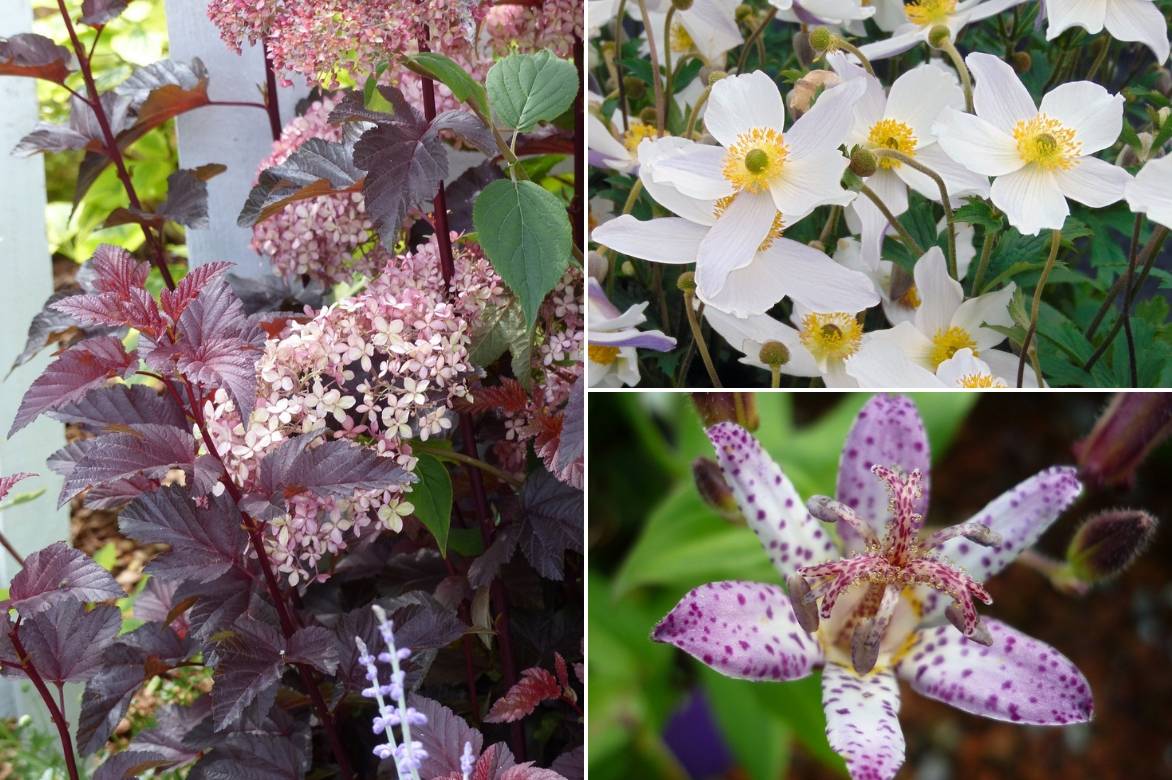
An example of a pairing: Hydrangea arborescens ‘Invincibelle’ and Physocarpus opulifolius ‘Diable d’Or’, Anemone ‘Wild Swan’ and Tricyrtis hirta
Choose also the evergreen, softly citrus-scented foliage of a Mexican orange blossom which will reward you, even after an initial spring flush, with a lovely late-season flowering.
Complete the scene with some ferns with striking form.
You can also play with foliage using the large, many-coloured leaves of Hostas or the Heucheras with inimitable hues.
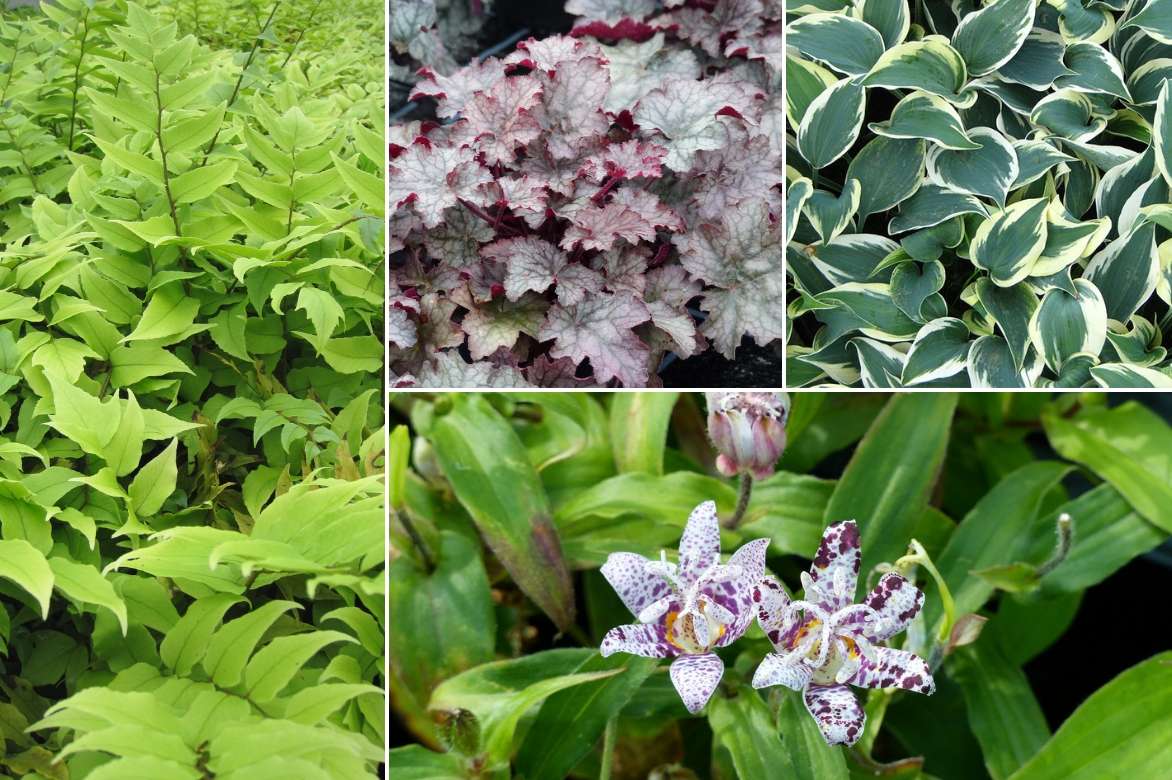
Another example of a pairing: Cyrtomium fortunei var. clivicola (to be replaced by Polystichum setiferum ‘Proliferum’ for example in harsher climates), Heuchera ‘Amethyst Mist’, Hosta ‘Blue Ivory’ and Tricyrtis hirta ‘Miyazaki’
The fine, bright foliage of an ornamental grass such as Hakonechloa will contrast with the broader, darker foliage of tricyrtis. In mild climates you can also opt for the incredible orange foliage of Uncinia rubra.
To tie the bed together, punctuate borders with a few Digitales whose tall, elegant flower spikes will add verticality and rhythm.
The tricyrtis only flower in autumn. To tide you over and dress borders from spring, choose bulbs such as snake’s-head fritillaries or shade-loving perennials such as Brunnera macrophylla or Claytonia sibirica.
Did you know?
If its Latin name is tricyrtis, this perennial is commonly called ‘orchid-lily’ because its star-shaped flowers resemble those of orchids.
The Japanese call it Hototogisu, a name also given to the cuckoo, a bird whose breast bears spots similar to those of the plant. For Anglo-Saxons it’s ‘poor man’s orchid’, but tricyrtis has also inherited a far less flattering name. Many in fact call it ‘toad-lily’ or ‘lily of the toads’.
Some say its tendency to grow in cool soil and shade is the origin of this name, as those are also places where toads like to shelter.
For others, the flowers’ speckled colouring recalls the appearance of this amphibian’s skin.
The Greek origin of the scientific name refers to the swollen nectar sacs at the base of the flowers. Some also see there a resemblance to the toad.
Finally, a legend says members of a Philippine tribe, the Tasaday, rubbed their hands with the sap of tricyrtis before going hunting amphibians. The smell was said to attract them and its sticky texture made it easier to grasp these slippery-skinned animals.
No one has yet said whether, after a kiss, the toad-lily ever turned into a prince charming, but one thing is certain: tricyrtis will bring princely charm to your shady borders!
USEFUL RESOURCES
Frequently asked questions
-
Why did my Tricyrtis disappear over winter?
It is normal for this deciduous perennial to die back in winter. New foliage sometimes does not reappear until April. If, however, nothing appears, that is more worrying. Tricyrtis is a hardy plant that can withstand temperatures down to about −12°C. But these figures apply to plants grown under the right conditions. Soil should remain cool during growth, but must not be saturated with water in winter. In addition, clayey, compact and heavy soils can harm it. Cold is never the only factor to consider when discussing plant hardiness.
-
My Tricyrtis leaves are browning. What should I do?
Orchid lily prefers humus-rich, consistently cool soil. Once well established, it can tolerate short periods of drought, but ensure soil does not become too dry during growth and flowering.
-
My Tricyrtis hasn't flowered this year. What's happening?
Tricyrtis is a sturdy, floriferous plant but can suffer from early frosts that destroy floral buds. Remember it prefers sheltered spots. It may also have suffered from lack of water during its growth period, leading to less generous flowering.
- Subscribe!
- Contents
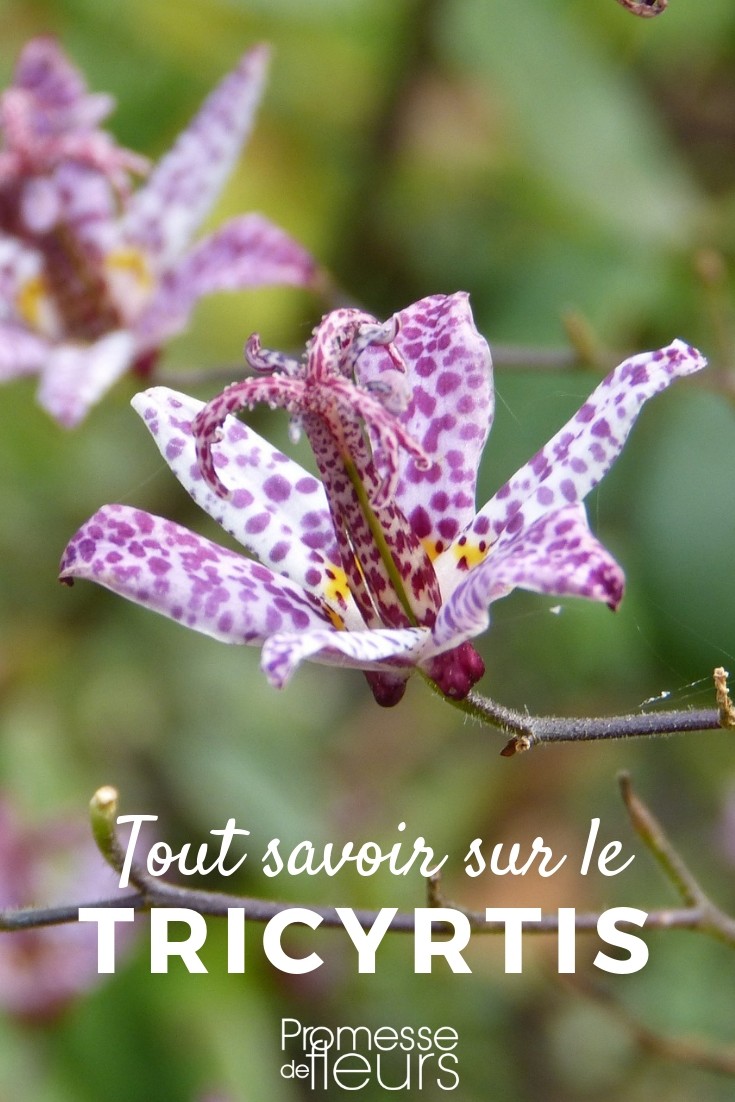































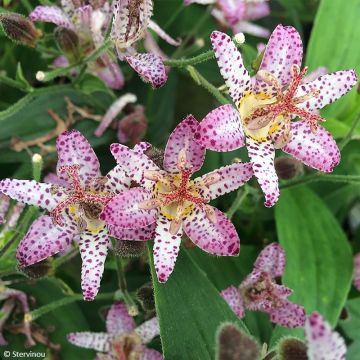


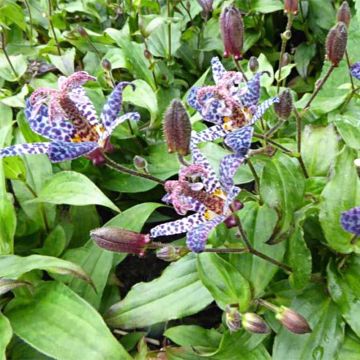
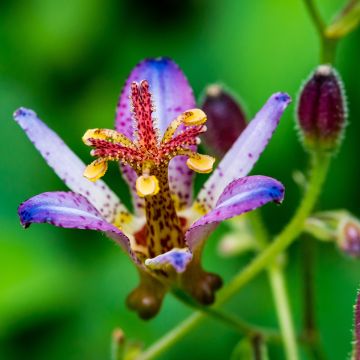
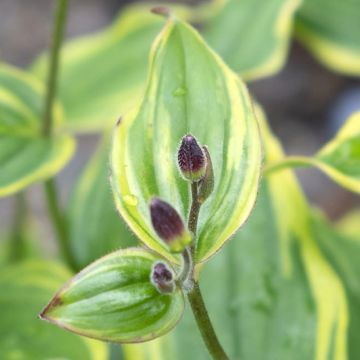


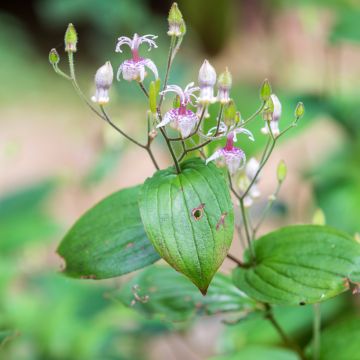

Comments